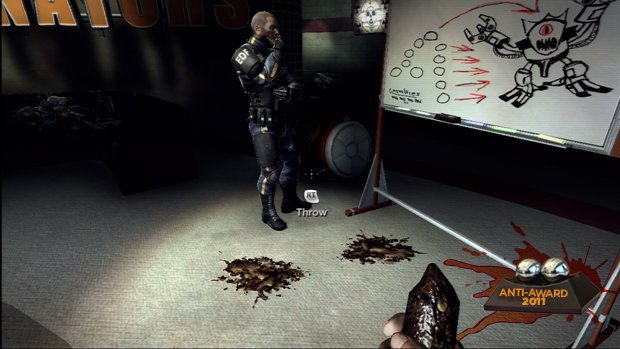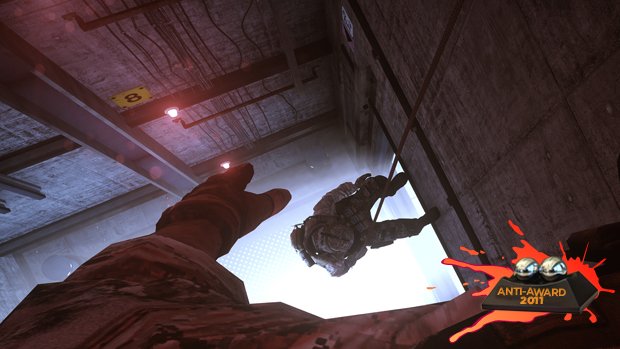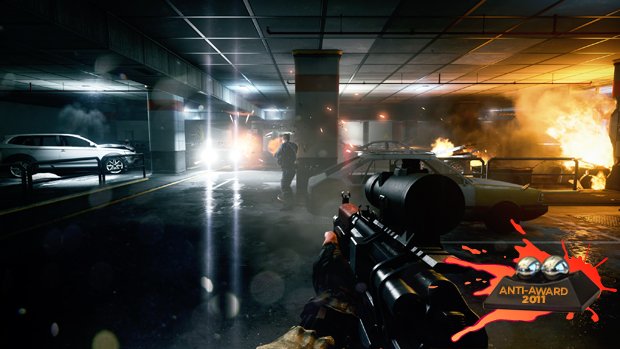The GamesRadar Anti-Awards 2011
The biggest offenders of the past year, strung up and ridiculed in front of the whole internet

A few weeks ago, we set aside our cynicism, put on our nicest smiles and threw a huge, three-part celebration in honor of all the cool stuff gaming brought us over the course of 2011. But now 2011 is over, and so are the Platinum Chalice Awards. It’s time now for another, darker tradition: the ceremonial dragging-out and clubbing of the worst games, moments and people that we had to endure over the past year.
Our “award” this year comes in the form of Duke Nukem’s Balls of Steel, a crass, useless special-edition bonus that we chose for reasons that will become apparent very quickly.
WORST GAME WE WERE LOOKING FORWARD TO:
Duke Nukem Forever

Back in 1996, when Duke Nukem 3D stomped onto the market, a bunch of us instantly became huge fans. So when the following year brought the announcement that Duke would return in the now-legendary-for-all-the-wrong-reasons Duke Nukem Forever, we were more than a little excited. And so we waited, eagerly, for more details. And we waited. And waited. And then waited some more. Eventually, we stopped waiting, and DNF became a cruel internet joke, synonymous with vaporware and dashed hopes.
After developer 3D Realms’ long-overdue demise in 2009, however, a handful of screenshots trickle out that made us wonder what could have been. And the following year, when we found out Gearbox was swooping in to rescue the project, we were overjoyed. We knew to temper our expectations, of course, but how could we not look forward to the release of a game we’d been denied for 15 years?
Turns out we should have tempered our expectations a lot more. Duke Nukem Forever took our revived hopes and smashed them face-first into a curb made of hideous graphics, dated gameplay and outrageously misguided attempts at edginess. As much as we’re looking forward to seeing what Gearbox does with Duke now that this is out of the way, DNF would have been disappointing even if we hadn’t been excited for it.
Runner-up: Homefront
WFF AWARD FOR WORST SIDEKICKS:
Battlefield 3’s campaign

Battlefield 3’s friendly NPCs almost don’t count as squad AI at all, such is their almost stubborn refusal to attempt the simulation of any kind of intelligence or human behavior at all. Where even half-decent AI will at least be aware of your in-game actions and react accordingly, even if it does so while running blindly to its own death for the 17th time in a row, Battlefield 3’s doesn’t even know you’re there. At all. Attempting to interact with it is like trying to start a conversation with one of the animatronic displays in a museum.
You’re sitting happily in cover? Well, screw you if you’re in the cover that the devs have decided – months before you got the game – that a certain AI character is going to use. He’ll get into position regardless, and push you straight out into the open. Waiting for the agonizingly scripted AI to open the next door so that you can progress? Sometimes they won’t bother. Or will clip straight through the door without opening it, leaving you behind. Battlefield 3’s campaign is less a game and more a 3D animated movie that you experience from the inside. But also that you keep getting booted out of because the actors don’t know you’re there.
Weekly digests, tales from the communities you love, and more
Runner-up: Gears of War 3 (for being too good)
WORST PART OF AN OTHERWISE GREAT GAME:
Battlefield 3’s campaign

OK, we’ve covered how unremitting Battlefield 3’s “friendly” AI is in its destruction of any sort of interactive fun you may attempt to have with the game, but it’s really just the final wrecking ball which ultimately flattens the shambolically shaky brickwork underpinning the whole sorry experience.
Battlefield 3’s campaign plays like a modern military FPS designed by someone who has had a modern military FPS described to them, but has never actually seen one and has no direct understanding of the actual human experience of playing one. All of the core elements are there on paper – scripted set-pieces, QTEs, vicious first-person close-quarters combat, “shocking” plot twists – but it’s all slapped together in such a scrappy, lumpen way as to come off more like a parody of the genre’s failings than an entry in its own right. Every trope is over-used to the point that the entire game is simply a semi-interactive lecture on game-design cliché. And to make matters worse, it can’t even be enjoyed as such, because the nuance-free, brute-force enemy AI is so moronically aggressive as to render the game nightmarishly difficult in all the wrong ways.
But multiplayer is brilliant.
Runner-up: Rage’s endgame
WORST MOMENT OF THE YEAR:
PlayStation Network gets hacked

The April-May PlayStation Network outage was certainly a low point for Sony this year, with 77 million compromised accounts and losses of upwards of $171 million. But the worst thing about the entire affair wasn't just the hacking itself, or that PSN was down for weeks – it was how Sony handled the entire debacle.
Nearly a week of downtime passed before users were notified that their information had been compromised due to an "external intrusion." A week! And we later learned that our personal information, including usernames and passwords, hadn’t been properly encrypted. Awesome.
Thankfully, there were no reported cases of credit card fraud that were tied to the PSN security breach, and Sony tried to make nice by offering free enrollment to an identity theft protection program as well as free games. While Xbox fanboys enjoyed a nice moment of schadenfreude, PlayStation owners were fuming for weeks, waiting nearly a month for PSN to go back up. Unfortunately, the developers that had released games in that period suffered the most, as players had no way of playing them online. And by the time they could, they’d stopped caring.
Runner-up: The miserable 3DS launch

Our expectations have lowered since the days when a system would launch with something on the level of Soul Calibur or Super Mario 64, but the 3DS launch this year was a joke. Sloppy ports, $40 games that lasted four hours, games that used 3D so poorly that they made us almost hate the feature. Even Nintendo pushed out half-baked yawns like Nintendogs + Cats and Steel Diver. The 3DS eventually recovered, but back in March, things were looking grim.
GamesRadar+ was first founded in 1999, and since then has been dedicated to delivering video game-related news, reviews, previews, features, and more. Since late 2014, the website has been the online home of Total Film, SFX, Edge, and PLAY magazines, with comics site Newsarama joining the fold in 2020. Our aim as the global GamesRadar Staff team is to take you closer to the games, movies, TV shows, and comics that you love. We want to upgrade your downtime, and help you make the most of your time, money, and skills. We always aim to entertain, inform, and inspire through our mix of content - which includes news, reviews, features, tips, buying guides, and videos.


